Breakfast is considered the most important meal in China. Some Chinese people like to make breakfast at home, while others prefer to visit local breakfast vendors for a quick and delicious meal on the way to school or work.
What did the Chinese eat for breakfast? This is a question we are often asked. Breakfast dishes widely differ from region to region, based on lifestyles, traditions, and personal preferences. Here in this article, we will discuss what people eat for breakfast in South and North China. These are the most classic breakfast options Chinese people love. (Check it out: The 20 Most Popular Chinese Dishes)
Most popular breakfasts in South China
#1. Morning Tea and Dim Sum
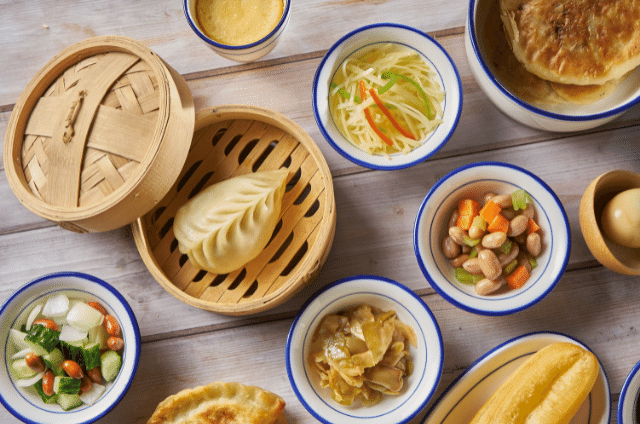
Dim sum means “touch the heart” in Chinese. It’s a Cantonese-style breakfast that people leisurely enjoy especially on weekend mornings. The small portions were designed to merely touch the heart not sate the appetite, and as such was first enjoyed as snacks. In ancient China travelers along the Silk Road broke their journey by stopping at tea houses. It was a great discovery for them that drinking tea can help digestion, which makes traveling easier and more enjoyable. Small pieces of food were offered along with the tea. Then the tradition of dim sum or yam cha (drinking tea) began.
Chinese Tea offered in Dim Sum restaurants has various interesting flavors, such as green, oolong, jasmine, and chrysanthemum. Food carts move around with lots of savory little snacks, that may be steamed, boiled, or deep-fried. Here is a snapshot of the most common dim sum to get you started, but there are many, many more!
- Siu Mai (open pork or prawn dumplings)
- Beef balls
- Egg Custard
- Lo Bak Goh
- Mango Pudding
- Sesame Seed Balls
- Har gau (steamed prawn dumplings)
- Cheong fan (rolled rice noodles) …
- Potsticker dumplings
- Char siu bao (bbq pork buns)
- Spring rolls
- Sesame prawn toast
With so many options of snacks to choose from, it’s easy to feel overwhelmed. To slow you down, order a few things from the menu first. While you wait and enjoy the food from the menu, you have plenty of time to see what they have to offer in the cart that you have not ordered and wanted to try. Get just two or three things at a time. You will probably have several rounds before you’re full. So don’t rush this meal, try to enjoy this relaxing and lingering atmosphere. For each round, try to aim for variety, not quantity. For example, have a steamer basket, a small plate of roast meats, and maybe something from the fryer. This way you will end up with a nice range of textures and flavors. Leave some room for a round or two of sweets. And remember always drink hot tea and ask for refills.
#2. Steamed Glutinous Rice (Zongzi)
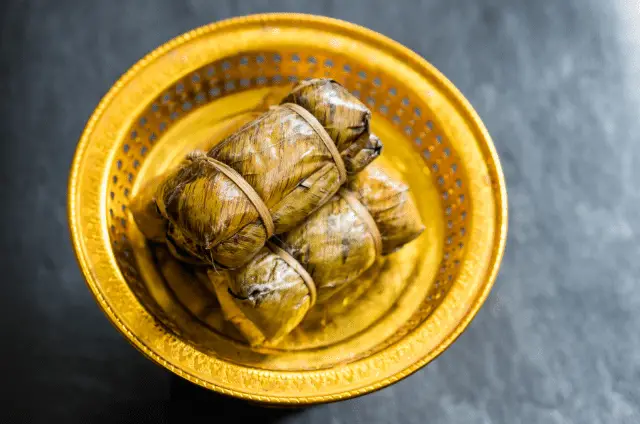
Zongzi is a leaf-wrapped sticky rice dumpling that is traditionally eaten during the “Dragon Boat Festival”. Though they are especially popular in the spring, it’s a snack enjoyed year-round in China. It’s basically a Chinese version of a tamale. It can be savory or sweet, and everyone has their favorite flavors. Compared to Beijing’s big sticky rice dumpling, Cantonese sticky rice dumpling is smaller in size.
There are many variations in Cantonese zongzi, mostly classified into two categories – the sweet one and the salty one. The sweet one contains Jianshui Joong (alkaline water sticky rice dumpling) and Dousha Joong(bean paste sticky rice dumpling). They can be made of Lotus seed paste, mung bean paste, red bean paste, chestnut paste, jujube paste, walnut, etc. The salty one that people mostly refer to is Meat Joong, filling with ham, fresh pork belly, salted egg yolk, roast chicken, roast pork, roast duck, chestnuts, mushrooms, shrimp, etc. The meat Joong is the most common glutinous rice dumpling in Guangdong. It is also the most favored one because of its abundant fillings.
No matter how tasty it is, it’s not a good idea to eat a lot of Zongzi at once. It is not easy to digest, as glutinous rice is really sticky and lacking in fiber. Always heat it before eating, as cold zongzi becomes very sticky and oily, so t is more likely to cause indigestion. People with diabetes should avoid eating it as zongzi contains greasy meat.
#3. Guilin Rice Noodles

Rice noodles are an essential part of daily life for modern Guilin residents. It is a staple of the local diet for thousands of years. The dish was first enjoyed over 2,000 years ago during China’s Qin dynasty (221 BCE). In Chinese, rice noodles are called “mifen”. Mifen restaurants can be found on just about every corner in Guilin, Guangxi Province.
The noodles are made of rice flour, water, and vegetable oil. Besides the noodles themselves, this flavor-packed meal includes quite a few ingredients, including gravy, meat, and toppings. When combined, these key ingredients melt together in perfect harmony to create a seriously satisfying meal. The gravy is a kind of brown sauce, which is considered the soul of the bowl. Its secret recipe may vary from shop to shop, but it’s typically flavored with some combination of Chinese herbs and meat.
Traditional mifen restaurants may be all the rage across Guangxi province, but many cities in this autonomous region have come up with their own take. For example, named the world’s smelliest noodles, luosifen is a one-of-a-kind dish due to its strong, sour scent and unusual ingredient: snail. It is very famous in Liuzhou city and spread all over the country.
#4. Tofu Pudding
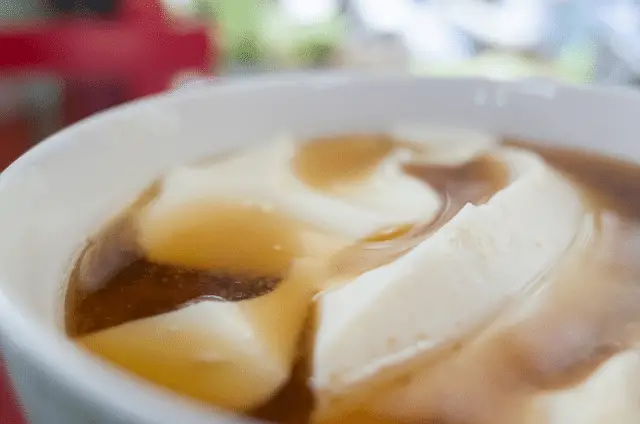
Tofu Pudding is also known as Douhua or Soy Pudding. It is a super popular Ancient Chinese dessert dating back to 122 BC! Tofu Pudding is so soft that it’s often served with a ladle. Besides being a sweet dessert, it is also enjoyed as a savory or spicy snack in different regions of China & Asia.
In northern China, it’s called Dou Fu Nao and served with various savory sauces (usually soy sauce-based) with fresh aromatics, pickles, and chili oil. The options are endless. In southern China, people usually call it douhua and serve it with gingery syrup. The most common way is to serve douhua with sugar water that has some ginger flavor. Some people like to add sweet red beans.
Tofu Pudding is made with soy milk and a coagulant to help it congeal. Nigari (magnesium chloride), gypsum (calcium sulfate), and glucono delta lactone (GDL) are often used as coagulants. Making douhua is a simpler process than making tofu. You simply need to dissolve the coagulant into the soy milk and let it set. Tofu pudding made with gelatin sheets may look slightly bouncy on the surface, but the thin curds that you ladle will actually feel soft, tender, and melt in the mouth.
#5. Wonton Soup

Nothing is more comforting than eating hot, soup-based dishes on a cold winter day. Wonton soup is an all-coveted Asian dish full of Chinese-inspired flavors. It is a standard Chinese breakfast made from seasoned chicken broth with filled wontons, an Asian equivalent of ravioli or tortellini.
The soup itself is clear bullion that is rich and flavorful with hints of shrimp, ginger, and toasted sesame oil. The wonton dumplings are like a meatball wrapped in a thin dumpling skin: firm, yet soft and juicy seasoned with ginger, scallions, and soy sauce. Unlike most other Chinese dumplings, wonton wrappers are squares or trapezoids. The wrappers are slippery, thin, and supple.
Wonton soup is a wonderful breakfast to boost your energy for the day. Wontons are meat-based dumplings, so it’s best to use a protein with some fat in it so the filling stays juicy and fluffy after cooking. Wonton soup is rich in protein as the fillings are usually pork and shrimp. In addition to the poultry, the soup also uses chicken broth as its base, which is also rich in protein. Each wonton is carb-heavy to equip you to handle various activities, even build-up of your muscles. Wonton soup is also full of vitamin B12, vitamin K, thiamin, pantothenic acid, and riboflavin.
Most popular breakfasts in North China
#1. Steamed Buns Stuffed with Meat or nothing
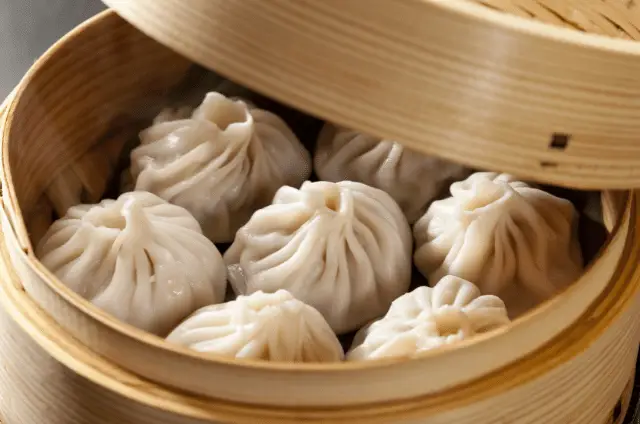
Known as baozi in Chinese, the steamed bun literally translates to “a little package”. It’s a popular breakfast staple served with congee. At its core, it’s a bread house that welcomes whatever stuffing your heart desires. The variations are endless across different cultures and regions.
Basic plain steamed buns (called mantou) are called mantou. They have no fillings, made of white wheat flour, but other ingredients, such as corn flour, sweet potato, and pumpkin, are sometimes added to the dough. Its basic recipe only requires 5 ingredients: flour, instant yeast, cooking oil, sugar, and salt. For a more fluffy and less chewy texture, use flour with a medium to low gluten level.
As the name suggested, steamed buns are usually steamed inside the bamboo steamer. Therefore, it is best to enjoy them when they’re right out hot and fluffy. Restaurants often serve baozi with pork or vegetable fillings. The texture of the buns is tenderly soft and moist, and when you take a bite, the inside is bursting with sweet-savory, juicy meat mixtures.
#2. Soybean Milk and Deep-Fried Dough Sticks
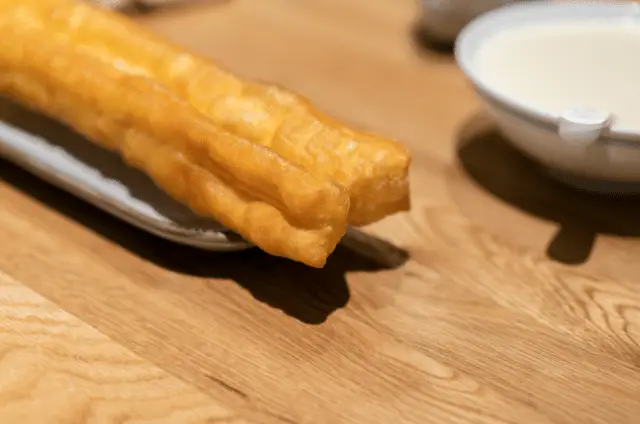
This simple, yet delicious breakfast combination is the most classic one in China. It consists of warm soy milk (dòujiāng) accompanied by crispy, deep-fried twisted dough sticks (yóutiáo).
If you happen to visit China, you will see many vendors set up their carts along the roadside and sell dough sticks and warm soy milk to passersby on their way to work or school. The creamy soy milk warms the belly and the crunchy dough sticks give a happy feeling of being full. It’s the perfect breakfast combination!
Youtiao, also known as Chinese fried dough or Chinese crullers, is deep-fried, leavened strips of dough that magically expand to chunky sticks in just a few seconds. It looks fascinating but making youtiao is quite a time-consuming and tricky process. So people prefer to buy from food vendors.
The soy milk is made of ground-up soybeans and is then filtered and boiled, fresh and ready for breakfast. The soybeans are filled with nutrients that help with digestion. You can drink soy milk hot or cold and since it’s so easily accessible in most retail supermarkets, many people don’t know how to make their own.
#3. Rice Porridge or Congee
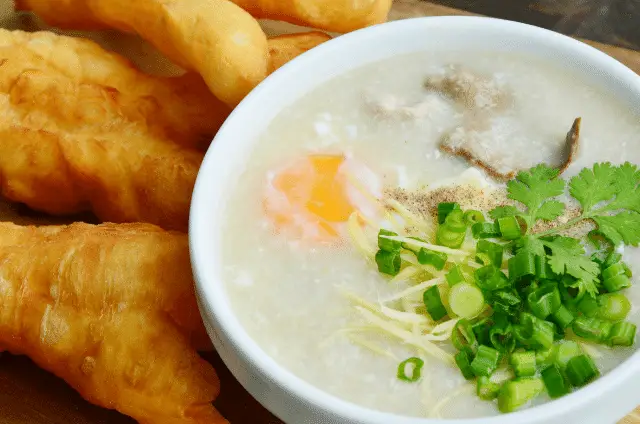
Rice porridge and Ccongee are classic Chinese breakfast staples. Cheap, filling, and truly delicious if prepared properly. Chinese people usually enjoy it with steamed buns or youtiao.
What’s the difference between rice porridge and congee? Rice porridge is simply rice cooked in liquid until it’s thick and creamy when it breaks down into a pudding-like consistency. But congee refers specifically to the savory rice porridge cooked with minced meat, seafood, and vegetables. Depending on the ingredients in the congee, the taste can be bland, sweet, or savory. The base is usually rice and water, but you can choose a beef, chicken, or vegetable stock. Restaurants often serve congee with flavorings like minced ginger and garlic, and toppings such as chicken, corn, mushrooms, or seafood. The flavor possibilities are only limited by your imagination and the ingredients in your kitchen.
It’s an economical dish that is easy to make and most often served to children and people who are ill or convalescing as it is easy to digest.
#4. Dumplings

Dumpling is the favorite comfort food for Chinese people. It is an integral part of holidays but can also be enjoyed any time of the day, and any day of the year. Boiled and pan-fried dumplings are the most popular options to enjoy this delicious food in the morning.
Chinese dumplings are more than pieces of dough with a filling. It’s a type of staple, just like rice and noodles. The crescent-shaped dumplings served during Lunar New Year symbolize the brightness of the moon and the promise of a bright and prosperous year ahead. Boiled dumplings are moist and juicy. Pan-fried potstickers have a nicely charred surface and crispy texture.
Shanghai soup dumplings (xiao long bao) is a regional variation. With a small bite of the soup dumpling, the hot and flavorful soup will drizzle from the filling. The handmade dumpling wrappers are thin, tender, and delicious. The filling is well balanced with meat and vegetable. It is not too greasy. Everything works perfectly together to create a fulfilling, healthy, and hearty one-dish meal.
#5. Jianbing

Jianbing is China’s most popular street breakfast. It is essentially a savory crisp-fried crêpes. It has bold contrasts of flavor and texture. Eggs are spread over the surface of the wheat and mung bean flour pancake as it cooks. Each one is cooked fresh to order on a circular cast-iron grill. It’s quick to make but impossible to do without months of practice and training.
Almost every city and town in China has its own Jianping vendor serving breakfast from dawn through mid-morning. The pancake is filled with crunchy puffed strips of fried wonton, some cilantro, scallions, and tangy pickles. Depending on your personal preference, you can choose a sweet or spicy layer of hoisin and chili sauces, which is spread on the back to taste.
The batter and fillings used in jianbing differ by region, and even by the vendor. For example, in Tianjin, vendors use you tiao (fried dough sticks) rather than fried wontons as filling, calling them jianbing guozi. Other fillings are different too, ranging from Chinese sausage to shredded carrot, grated radish, chicken, or even—in cosmopolitan Shanghai—strips of crisp-fried bacon.
#6. Wheat Noodles

Wheat noodles are made with wheat flour, salt, water, and sometimes eggs and flavorings. A hot bowl of wheat noodles in the morning is a very satisfying breakfast, especially in the morning.
(Check it out: Chow mein VS Lo Mein)
It’s easy, and quick to make. Just boil the noodles in a pot of water. Toss them about to prevent them from sticking together. Add an egg, some vegetables, or meat (such as beef slices) to make it a well-balanced meal. Asian grocery stores often carry several varieties of dried Asian noodles, which can be stored indefinitely. They also carry fresh noodles, which can be kept for two or three days in your refrigerator.
Just like many other staples we’ve talked about in this post, wheat noodles have different variations by region. In Sichuan province, Spicy Dan Dan Noodles is seasoned with chili oil, sesame paste, black vinegar, and soy sauce for a strong flavor. Cold noodles with shredded chicken is also a Sichuan dish. It’s an extremely popular street food across China during the hot summer months. In Wuhan, the most popular noodle is Hot and Dry noodle. The main seasoning is tuned sesame paste and it’s topped with picked spicy radish and scallions.
#7. Scallion oil pancake

Chinese scallions oil pancake is also known as green onion pancake or congyoubing. It is one of the most famous and traditional Chinese street foods and an ideal Chinese breakfast. Many people follow easy-to-make recipes to make them at home.
These crispy pancakes with a scallion aroma are available all around China. But there are several different types. In northern provinces, scallion pancake is thinner, chewy, and with less oil. In Southern China, for example, in Shanghai, scallion pancakes are thicker and fried with a larger amount of oil and create an even more crispy shell and softer inner part.
Scallion pancakes have a crispy and flaky exterior with a slightly chewy interior of thin layers. It is extra crunchy and addictively fragrant when cooked fresh out of pans. You can eat scallion pancakes for breakfast, lunch, as a snack, or even for dinner! If you make it at home, the best part is that you can customize it based on your cravings. Adding fried egg, ham, corn or vegetables are all wonderful options for a healthy meal.
#8. Tea eggs
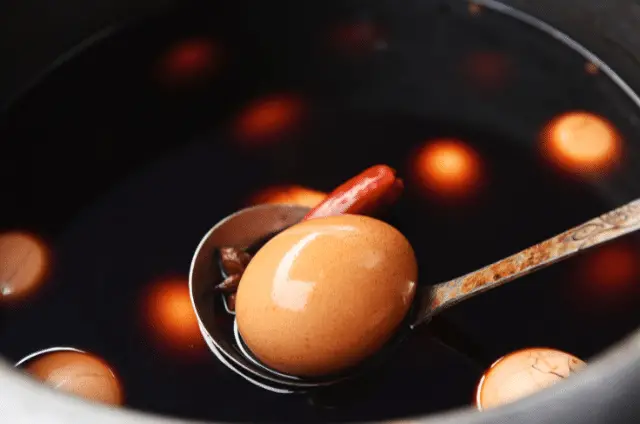
Chinese Tea Eggs (also known as Marbled Tea Eggs or Tea Leaf Eggs) are a very popular snack in China. Many Chinese food vendors serve them during breakfast time.
Tea eggs have a beautiful marble-like pattern on the egg white. They are simmered in a savory liquid with star anise, cinnamon sticks, Sichuan peppercorns, and black tea until soaked with the flavors of the spices and a refreshing tea fragrance.
Traditionally, tea eggs need to be cooked twice. The eggs are cooked until hard-boiled the first time and then cooked in a savory marinade for several hours. It’s like giving plain and dry hard-boiled eggs a makeover. To achieve a marble-like pattern on the egg, the eggshells need to be cracked (but not peeled) before stepping in the flavored liquid.
#9. Egg & Scallion Crepe

Like most crepe recipes, this Chinese-style egg & scallion crepe is not hard to make at all. It only requires 6 basic ingredients and 15 mins cooking, but it can easily lighten up the mornings. The only tricky part is to achieve the right consistency when mixing the batter, which includes flour, water, eggs, salt, ground pepper, and scallions.
After pouring the batter into a hot frying pan, allow it to flow freely until it forms a thin, round shape. Cook both sides until slightly browned. Move the pan back and forth to test if it’s ready to be flipped over. They taste best when served warm. You can also add some veggies for a healthier breakfast. Grated zucchini, carrot, or coarsely chopped spinach are all great choices. Another way to brighten up your morning crepe time is to add some colorful juice to the batter (replacing the same amount of water).
#10. Steamed Eggs
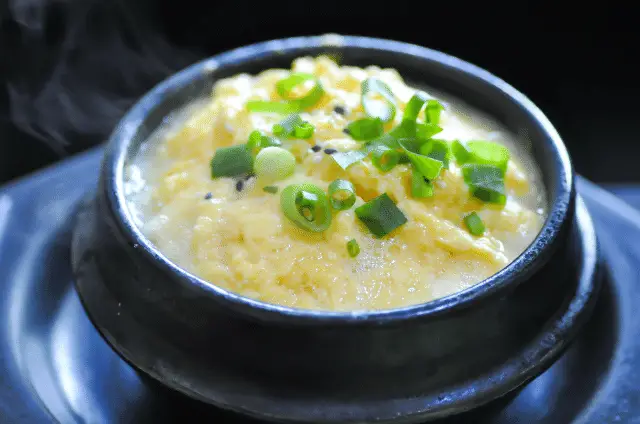
Another Chinese breakfast dish that requires minimum ingredients yet delivers a delicate look and amazing taste. Chinese steamed eggs, also known as water egg or egg custard, is a super simple dish that many Chinese people grow up with. It’s usually cooked at home because the process is so simple and straightforward. You just need to beat the eggs, add water (or chicken broth) then steam. However, if you want to achieve a smooth, slippery, and heavenly soft texture, the ideal egg water ratio should be around 1:2 in volume. Warm water works best here.
You can make these Chinese steamed eggs without owning a bamboo steamer or a special steaming pot. I’ve tried using the microwave before. It took some trial and error, but it worked out eventually. After the dish is done, simply add some light soy sauce and sesame oil, and cut through the curd several times to let the sauce penetrate. If you want it to be more nutritious, add some shrimp or veggies before steaming.
